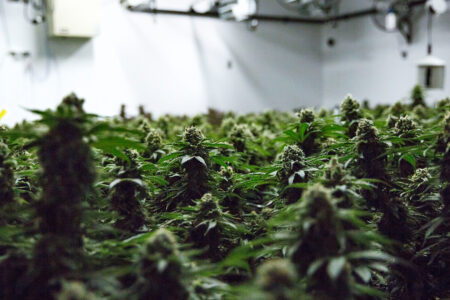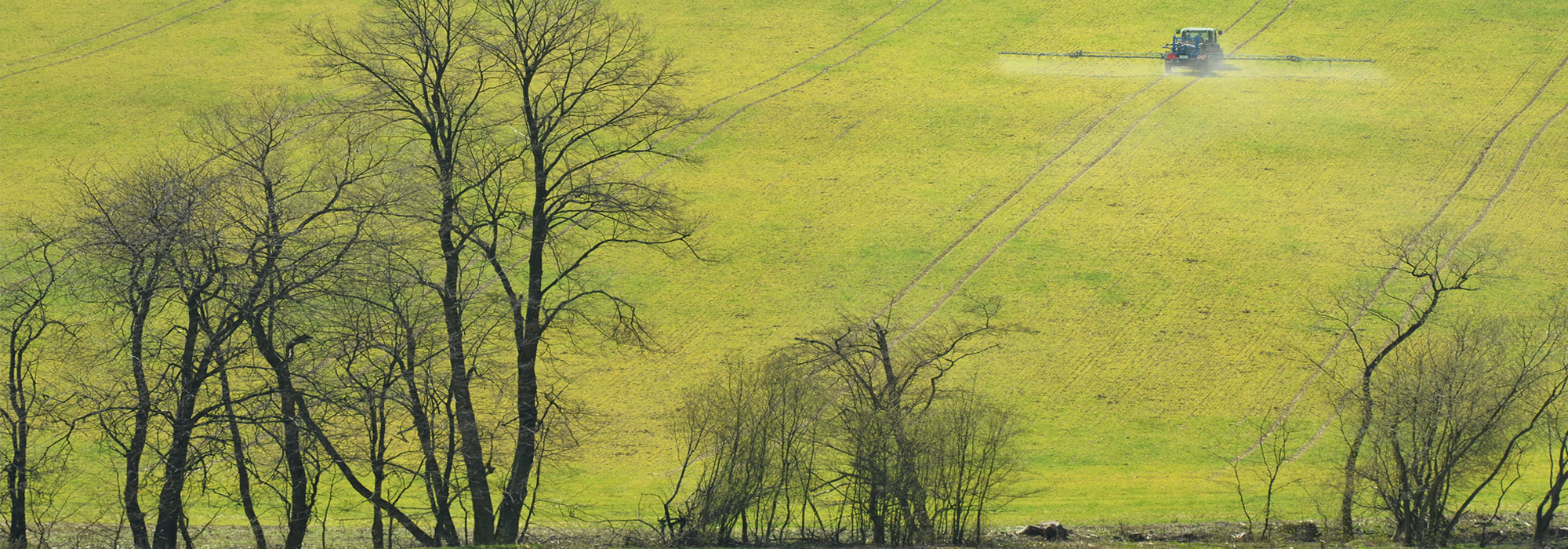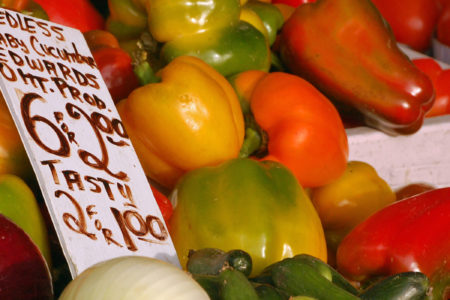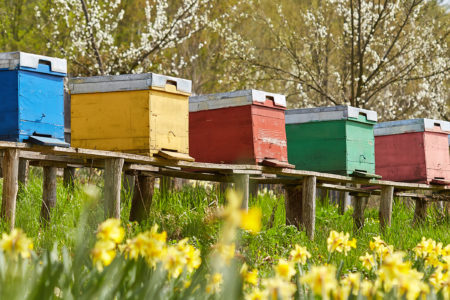
Neonicotinoids (neonics) are the world’s most widely used insecticides, representing fully one-third of all pesticides currently on the market. Neonics are used in farming to treat seeds, soil and leaves. They’re also used to treat fleas in domestic animals and are a staple of domestic and commercial lawn products. Neonic-treated seeds have quickly become the norm on the North American market, so much so that any farmer wishing to plant untreated seeds is up against severely limited options.
A slow and fragmented re-evaluation process
In Canada, the re-evaluation process for neonics and their risks to pollinating insects didn’t get under way until 2012. Products are periodically re-evaluated to assess their effectiveness and stay abreast of updates from other countries. In 2012, the Pest Management Regulatory Agency (PMRA) — the Health Canada agency in charge of the process — received an unusually high number of reports of bee mortality during the planting periods of neonic-treated corn and soybean seeds. In response, the PMRA upped its monitoring of the regions where the incidents occurred. Based on data provided by the provinces, the agency concluded that bees were being exposed to neonics through the contaminated dust generated during planting.
In November 2016, following its pesticide health and environmental risk re-evaluation, the PMRA proposed gradually phasing out imidacloprid, one of the neonics approved for use in Canada. The findings released by Health Minister Jane Philpott were unambiguous: “The environmental assessment showed that, in aquatic environments in Canada, imidacloprid is being measured at levels that are harmful to aquatic insects…Based on currently available information, the continued high-volume use of imidacloprid in agricultural areas is not sustainable.”
The PMRA’s announcement sparked an outcry from chemical industry lobbyists who attended the House of Commons committee hearings, causing the minister to reassert her position on the eventual ban of imidacloprid for agricultural uses within the next three to five years.
Health Canada expects to issue its final ruling on imidacloprid in December 2018. The proposed timeline for phase-out would therefore be between 2021 and 2023 — in the distant future.
What about other pesticides? Three neonics used in Canada were evaluated separately rather than benefiting from a single approach aimed at assessing their full impact on ecosystems and human health.
What’s more, the science has rapidly evolved throughout the PMRA’s ongoing five-year evaluations, while we all continue to be exposed to these pesticides in the environment.
The scientific consensus is clear: the continued use of neonics in agriculture is unsustainable and compromises the very basis of agriculture.
Neonics: A failure in pest management
This past September, the independent group of international scientists known as the Task Force on Systemic Pesticides (TFSP) released an updated version of its Worldwide Integrated Assessment of the Impact of Systemic Pesticides on Biodiversity and Ecosystems.
The findings are alarming: neonicotinoids pose a serious threat to biodiversity, ecosystems and food security worldwide. Based on a synthesis of over 1,100 published peer-reviewed studies along with data from the pesticide manufacturers, the review identified clear evidence that neonics are harmful not just to honeybees, but also to a great many other beneficial species: aquatic insects, terrestrial invertebrae (e.g., earthworms) and birds.
Closely monitored by beekeepers, bees are to a degree the canaries in the coal mine. However, the impact of neonics on wild pollinator populations and on the full range of ecosystem services delivered must also be examined, as the TFSP has done. The Task Force came to Ottawa to inform Canadian authorities and decision-makers of its findings during an event organized by the David Suzuki Foundation.
In the European Union, three neonics have been subject to heavy restriction since late 2013. The measure encompasses seed and soil treatments for bee-attractive crops (with the exception of greenhouse uses and winter cereal crops) as well as foliar treatment for these crops. France is to ban the use of neonics as of September 2018.
In terms of crop yield, the TFSP’s findings indicate little decline in productivity when neonicotinoid insecticides are not used. In Quebec, the Centre de recherche sur les grains (CEROM) established that the use of seeds treated with neonics was justifiable only on approximately 3.7 percent of the major crop fields screened.
Furthermore, harm to the predators of insect pests cancels out the anticipated benefits of neonics, resulting instead in an upsurge of unwanted insects. As Équiterre has already underscored, overreliance on synthetic insecticides for pest management results in severe damage to the ecosystem services that support agricultural productivity.
According to the TFSP, it’s increasingly clear that the global neonics experiment is a pest control failure. Effective integrated pest management (IPM) tools that maintain agricultural productivity are already available. Adopting rigorous IPM practices and setting up insurance mechanisms can also help mitigate the financial risks for farmers as we transition away from neonics.
Based on these findings, Équiterre maintains that a science-based pesticide regulatory process can only conclude that a complete ban on the use of neonics in agriculture is needed in Canada. Any other decision risks undermining public confidence in the rigour, transparency and nonpartisanship of the evaluation process.
As for the ban on imidacloprid, Équiterre and the David Suzuki Foundation find the proposed time frame for phase-out unacceptable, given the risks found in the PMRA’s re-evaluation and the high concentrations of the product in Canadian surface waters. The two environmental groups are calling on Health Canada to bring the ban into effect as of 2018.
Faced with the lack of federal government action, some provinces have enacted measures to curtail the risks of neonics. This is the case in Ontario, which in 2015 adopted new regulations targeting an 80% reduction in the number of acres planted with neonicotinoid-treated corn and soybean seeds. Quebec, in turn, has proposed a regulatory amendment that would prohibit the use of neonics in farming unless prescribed by an agronomist who can justify their use.
What does the future hold?
Federal law stipulates that the Minister of Health must be satisfied that a pesticide does not pose any unacceptable risks to human health or the environment before it is put on the market. Nonetheless, some ten years ago, the PMRA granted conditional registrations to two neonics, clothianidin and thiamethoxam, effectively authorizing their sale in Canada despite lacking the full scientific data on their impacts. Fast-forward to today where, with both pesticides still in use, the PMRA has yet to receive the manufacturers’ data that would justify their full registration. As a result, in 2016, Ecojustice filed a lawsuit in federal court against the PMRA on behalf of a number of environmental groups. The suit aims to prove that clothianidin and thiamethoxam should never have been registered in Canada in the first place and that accordingly the PMRA has violated federal law.
Still, we can take some comfort in the fact that this “approve now, study later” approach has since been prohibited in Canada, following new directives from Health Canada.
Legal proceedings were also launched in Québec and Ontario in 2014 against neonic manufacturers Bayer and Syngenta on behalf of beekeepers whose business has suffered from the pesticides’ effects on their honeybees.
It remains to be seen whether the future of neonics in Canada will ultimately be determined by the rigour of the PMRA’s process — or the courts.
How can such a slow, cumbersome and fragmented federal regulatory system stay current and take into account the latest scientific research worldwide? And how is the public to trust in its ability to protect our health, food security and environment?
In that sense, Health Canada’s ruling on neonics this month will be critical.
Photo : Shutterstock / kovop58
Do you have something to say about the article you just read? Be part of the Policy Options discussion, and send in your own submission. Here is a link on how to do it. | Souhaitez-vous réagir à cet article ? Joignez-vous aux débats d’Options politiques et soumettez-nous votre texte en suivant ces directives.









